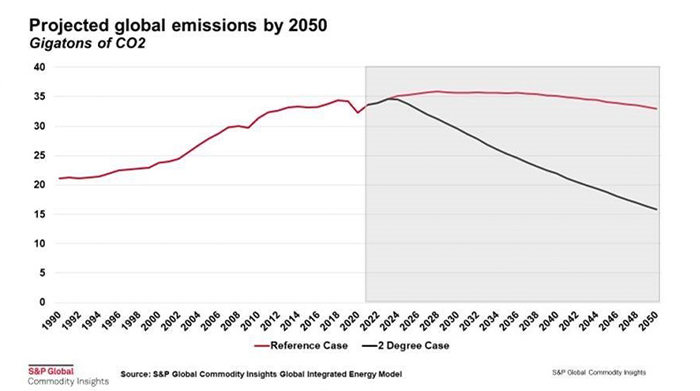COP27: Climate Change Fight Turns Focus To Food

Transitioning to regenerative agriculture, utilizing upcycled food streams, increasing biodiversity in land use, adopting plant-based lifestyles and, of course, reducing carbon footprints, are among the most common sustainability claims in the food industry, and these topics are set to play key roles in current global conversations around climate change.
The 27th Conference of Parties (COP27), hosted by United Nations Framework Convention on Climate Change (UNFCCC), began on Sunday in Sharm El-Sheikh, Egypt with negotiation teams from 197 countries, international nonprofits, industry experts and climate focused investors convening to discuss and potentially implement frameworks for tackling climate change.
Over the next 10 days, discussions will center around a specific daily theme, and for the first time in the conference’s nearly 30-year history, Agriculture Day has made the agenda. The day will see a round table discussion aiming to develop a plan to reduce the global food system’s role in climate change, considering it generates one-third of man-made greenhouse gas (Ghg) emissions. Additionally, COP27 will mark the debut of a Food Systems pavilion.
“While it’s long overdue, we are encouraged to finally see COP incorporate agriculture and food systems into its agenda,” said Angie Crone, Upcycled Food Association interim CEO. “Food and agriculture contributes an estimated 25% of greenhouse gas emission and uses 70% of freshwater use and half of all habitable land. We – particularly in wealthier nations – are overspending our natural resources, including wasting up to a third of all food produced globally.”
COP26, held in Glasgow, Scotland last year, produced a framework for nations to make GhG emission reduction commitments; however, political turmoil like the war in Ukraine and subsequent energy crisis, the impact of extreme weather events and the continued global inflation caused by the COVID-19 pandemic, has stalled on progress toward many of those pledges.
Despite these events, the U.S. has remained relatively on track, largely supported by the passage of the Inflation Reduction Act earlier this year, which allocated over $11 billion to support clean energy and energy infrastructure innovation.
Globally, however, current commitments, and subsequent progress, are not enough to limit global warming to below 1.5°C by 2050, which was affirmed as an international goal by the Paris Agreement in 2015 at COP21. The agreement was signed by 197 nations and covers climate change mitigation, adaptation, and finance in support of that goal. This year, COP27 is expected to largely focus on creating frameworks to implement commitments.
The Role Of Regenerative Agriculture
According to the United Nations Climate Champions team, a group of delegates advocating for the frameworks presented at each COP event, regenerative agriculture and other nature-based climate change solutions are essential to emissions reduction goals. The group cites data that found regenerative practices have the ability to sequester 10 gigatons of carbon annually and make land use net zero by 2030. Nonprofit groups in attendance, including The Rainforest Alliance and The Good Food Institute, also cited the opportunity to eliminate the 20% of global emissions produced from animal agriculture and 8% from food waste by shifting toward a regenerative food system.
Initiatives like the Koronivia Joint Work on Agriculture (KJWA) program are on the docket for discussion and address how soil, nutrient use, water, livestock, and methods for assessing adaptation can be measured and scaled to promote regenerative systems globally. The program was developed by the Food and Agriculture Organization of the United Nations (FAO) and also addresses the relationship between socio-economics, food security and agriculture to climate change. KJWA will be presented as a short term solution for reducing GhG emissions and a long term framework for developing a stable and resilient global food supply.

“We have also proven that through regenerative organic practices applied in the appropriate context, farms and communities can actually thrive,” said Elizabeth Winslow, executive director at Regenerative Organic Alliance (ROA). “We need meaningful change driven by farmers, eaters, and companies who support a radical transformation of our ag and food systems that does not look to chemical companies and big food for answers.”
At COP26, the U.S. and U.A.E launched the Agriculture Innovation Mission (AIM) for the Climate, which has since double its investments dollars to $8 billion and, at COP27, will deploy $1 billion for innovation sprint funding toward its current focal areas: smallholder farmers in low- and middle-income countries, methane reduction, emerging technologies and agroecological research.
The Plant-Based Piece of The Puzzle
Extreme weather events and political upheaval have underscored the global scarcity of natural resources this past year. Leaders from Brazil, Indonesia and the Democratic Republic of Congo are expected to present a united call for support from donors to combat rainforest deforestation. Nearly three-quarters of the Amazon has been deforested to create usable land for animal agriculture since 1978, but rising interest in plant-based food and support for regenerative agricultural practices could present alternatives.
Industry interest groups like The International Plant Based Foods Working Group (IPBFWG), a newly established arm of the Plant Based Food Association, praised the agenda’s definition of a sustainable global food system as one that promotes the adoption of plant-based eating.
“Plant-based foods are a multi-problem solution, be it sustainability, land degradation, biodiversity loss, climate change, health hazards and ethical concerns,” said Sanjay Sethi, IPBFWG member and executive director of Plant Based Foods Industry Association (India), in a statement. “To feed the ever-growing global population, we must shift to a more efficient food system centered towards plant-based foods.”
Upcycled Food Emerges
The Upcycled Food Association chimed in to highlight how upcycling waste streams are essential to “keep 1.5°C alive,” stating that both governments and companies must set concrete carbon-reduction targets and shift their focus to financing waste reducing food system solutions like “crop preservation, post-harvest loss prevention, byproduct utilization and upcycling along with regenerative and sustainable growing practices.”
“We are seeing huge momentum in the upcycling movement, which is now a $53 billion industry globally,” said Crone. “The merger of Misfits Market and Imperfect Foods, which collectively have diverted 500 million pounds of food waste from ‘lesser outcomes’, in addition to industry heavyweights like Kroger and Whole Foods stocking more upcycled products, are all indicators that the upcycling movement is a key puzzle piece to mitigating climate change… [Now] there’s a real need for consumer awareness and education, because they want to be part of the solution.”
Collectively, food and agriculture nonprofits are arguing for the adoption of science-based emission reduction targets and a more regenerative food system with many highlighting the current events noted above as an impetus for a more rapid transition. COP27 has the potential to wholly address emissions by taking stock of the progress that’s been made and create additional goals bringing the food supply chain into focus.
What’s next?
With a core set of problems defined and a swath of solutions on the horizon, negotiations at COP27 will likely center around how capital will be generated to achieve those goals and where it will be deployed. According to the UN Climate Champions team, financing will need to increase “10-fold” in order to complete the necessary overhaul of agriculture and food systems by 2030 to ensure food and economic security.
In the U.S., President Biden has pledged to work with Congress to contribute $11 billion to international climate finance each year, making it the largest contributor to this sector. Comparatively, the Future of Food, an alliance of philanthropic foundations, found that global governments only direct 3% of climate finance toward food and agriculture and 70% of countries don’t include the food system in their climate plans.
“While the environmental degradation caused by food systems is multifactorial, evidence shows that even if fossil fuel emissions were eliminated immediately, food system emissions alone would make it impossible to reach 1.5°C, and sustainable diets play a key role,” stated members of the FAIRR Initiative in a letter to the UN FAO.
FAIRR is an investor network representing $18 trillion in combined assets that focuses on the environmental risks and opportunities of livestock production. Ahead of COP27, the group is advocating for the UN FAO to create a global roadmap to achieving the Paris Agreement climate goals inclusive of the agriculture and land-use sectors. FAIRR member investment firms include Big Idea Ventures, Boston Trust Walden, SOSV, Unovis Asset Management, Vancity Investment Management, Clear Skies Investment Management, among others.
“As investors, we recognize the financially material risks to which the food system is exposed, from climate change, biodiversity loss, malnutrition, and antimicrobial resistance, as well as the material impacts that food system activities have on the environment,” FAIRR member state in the letter. “It should be clear to companies and other stakeholders in the sector, what volume of emissions must be mitigated to limit warming to 1.5°C, and the role each subsector must play in this mitigation.”
















